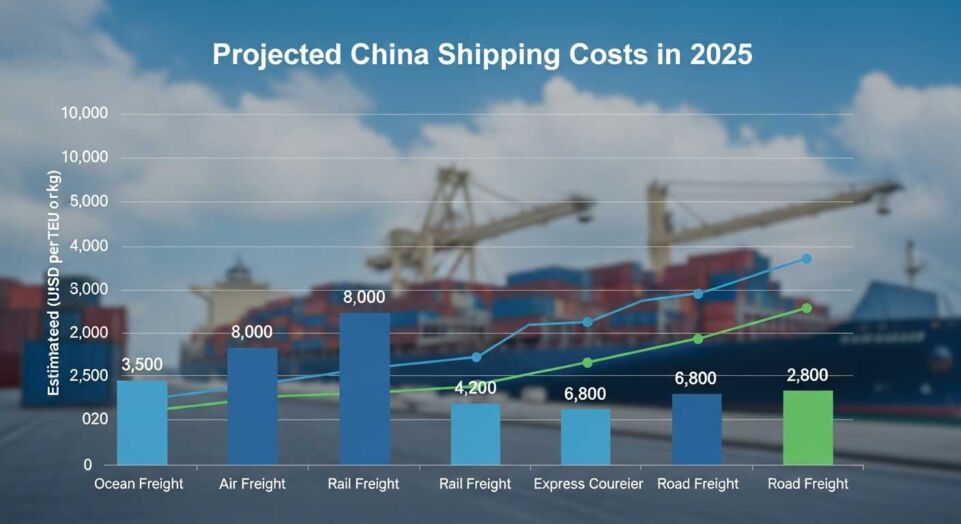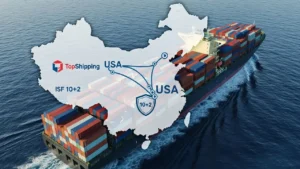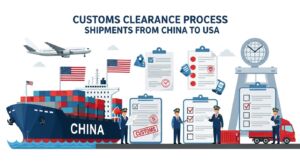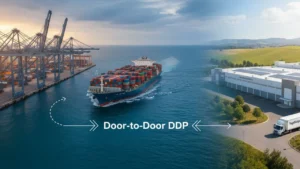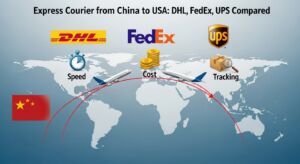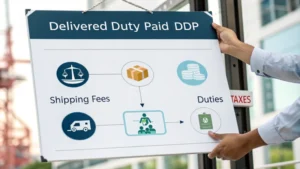In 2025, shipping costs to and from China have seen a significant decline, which is good news for importers. This decrease started early in the year and is expected to continue throughout the peak shipping seasons. Reports indicate that container shipping rates from Shanghai to the U.S. and Europe have dropped, and 40-foot container rental prices have also fallen.
However, costs have not yet returned to pre-pandemic levels, i.e., before 2019. The China shipping market remains unstable, and rate fluctuations can occur in the short term.
Importers are advised to check rates and carefully plan their shipments before placing orders. The lower shipping costs provide a good opportunity to save on logistics expenses.
With careful planning and timing, importers can take full advantage of these reduced rates.
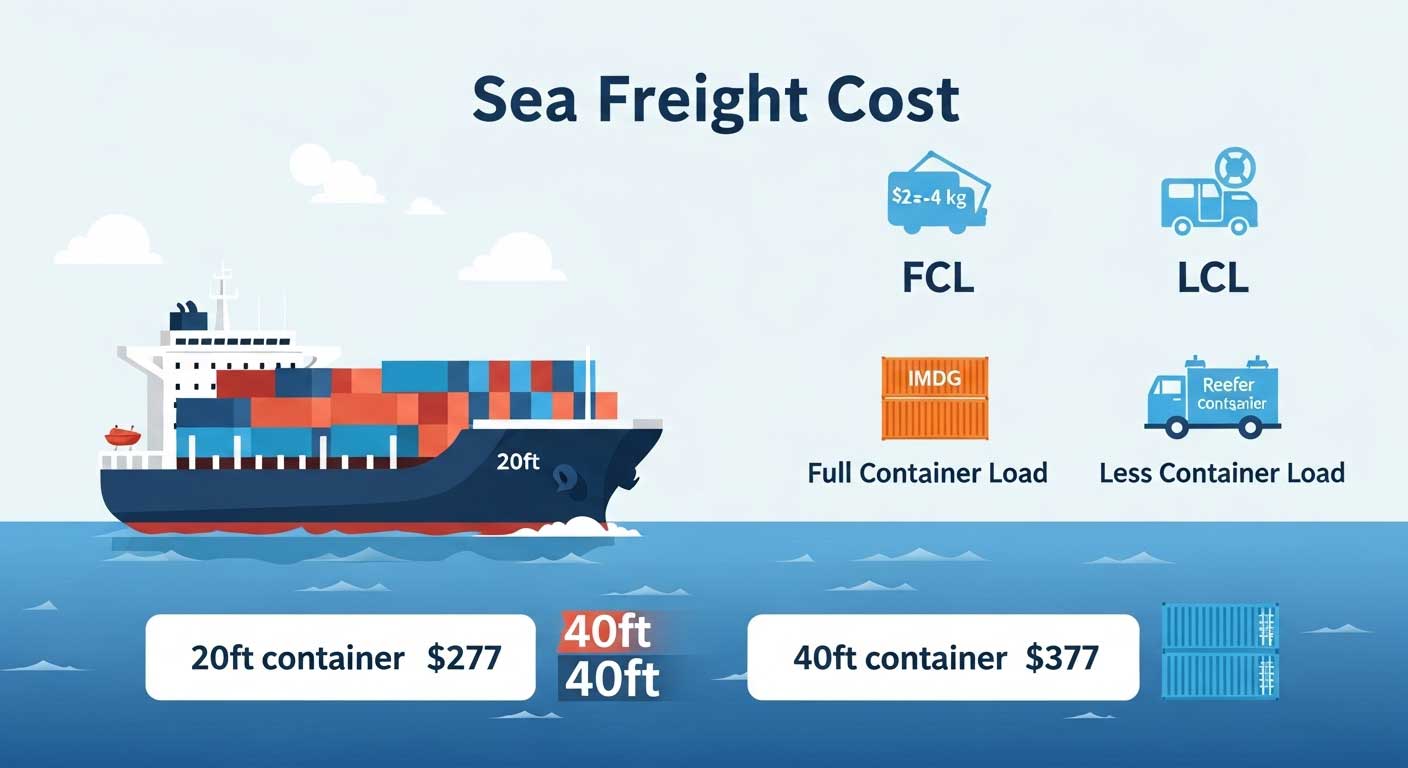
What is the Sea Freight Cost ?
Sea freight is one of the most cost-effective ways to transport goods internationally, making it a popular choice for importers handling bulk or heavy shipments.
This shipping method is ideal for cargo weighing over 500 kg and is typically transported in 20ft or 40ft containers.
- IMDG containers are used for hazardous goods to ensure safe transportation.
- Reefer containers are designed for perishable or temperature-sensitive items, maintaining quality throughout the journey.
Types of Sea Freight Shipments
FCL (Full Container Load):
In this method, a full container is dedicated to a single shipment. FCL (Full Container Load) is ideal for large or high-volume cargo, providing more control over the shipment and faster handling.
LCL (Less Container Load):
LCL consolidates multiple smaller shipments into one container. This option is cost-effective for smaller shipments, but costs are calculated based on both weight and volume.
Sea Freight Costs from China to the U.S.
- Cost per kilogram: typically $2–$4 per kg, depending on the cargo type and shipping route.
- 20ft container shipping cost: approximately $277
- 40ft container shipping cost: approximately $377
Choosing between FCL and LCL, as well as the container type (standard, IMDG, or Reefer), can significantly impact the overall sea freight cost. Proper planning ensures you get the most efficient and economical shipping solution.
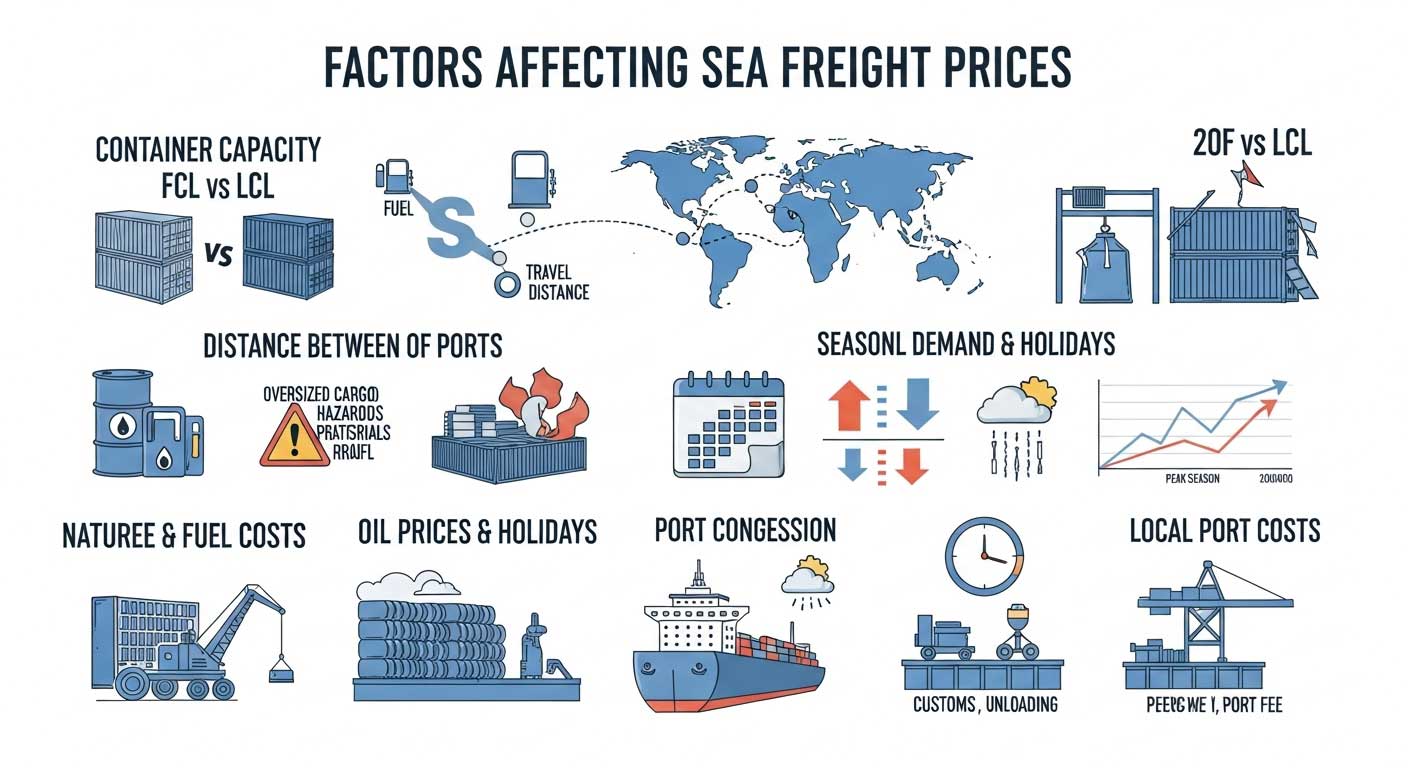
Factors Affecting Sea Freight Prices
Understanding the factors affecting sea freight prices is essential for businesses and importers to plan shipping budgets efficiently and optimize logistics. Several key elements determine how much sea freight will cost for a shipment from one port to another.
1. Container Capacity
The choice between FCL (Full Container Load) and LCL (Less Container Load) directly impacts shipping costs.
- FCL shipments maximize container space, reducing the cost per unit.
- LCL shipments consolidate smaller shipments into one container, which can increase per-unit costs due to additional handling and logistics.
Selecting the right container type is crucial not only for cost-efficiency but also for overall supply chain planning.
2. Distance Between Ports
Shipping cost is highly influenced by the distance between the port of loading and the destination port.
- Longer distances increase fuel consumption, labor costs, and transit time.
- Crossing multiple borders or regions with higher tariffs can further raise costs.
Careful route planning helps minimize expenses while maintaining delivery efficiency.
3. Nature and Size of Goods
The type, size, and nature of cargo significantly affect freight prices.
- Bulky, oversized, or hazardous goods require special handling and may incur higher charges.
- Fragile or perishable items often need climate-controlled containers, increasing shipping costs.
Proper classification and packaging ensure compliance and prevent unexpected fees.
4. Oil Prices and Fuel Costs
Fuel is a major component of sea freight expenses.
- Rising oil prices lead to higher shipping costs, while lower oil prices can reduce them.
- The volatility of fuel costs requires careful planning and budgeting to avoid disruptions in logistics expenses.
5. Seasonal Demand and Holidays
Freight rates fluctuate during peak seasons, holidays, and harvest periods.
- Increased demand for shipping services drives prices up.
- Adverse weather during certain seasons can cause delays, leading to additional costs or the need for expedited shipping.
6. Port Congestion
Congested ports can significantly increase shipping costs.
- Delays in berthing, loading, and unloading may lead to demurrage charges and inefficiencies in the supply chain.
- Shippers may incur extra fees if shipments are diverted to alternative ports to avoid congestion.
7. Local Port Costs
Local port fees, including docking, unloading, and customs clearance, vary depending on labor costs, regulations, and port infrastructure.
- Ports with higher operational fees increase the overall shipping cost.
- Choosing ports strategically can help reduce expenses while maintaining smooth cargo flow.
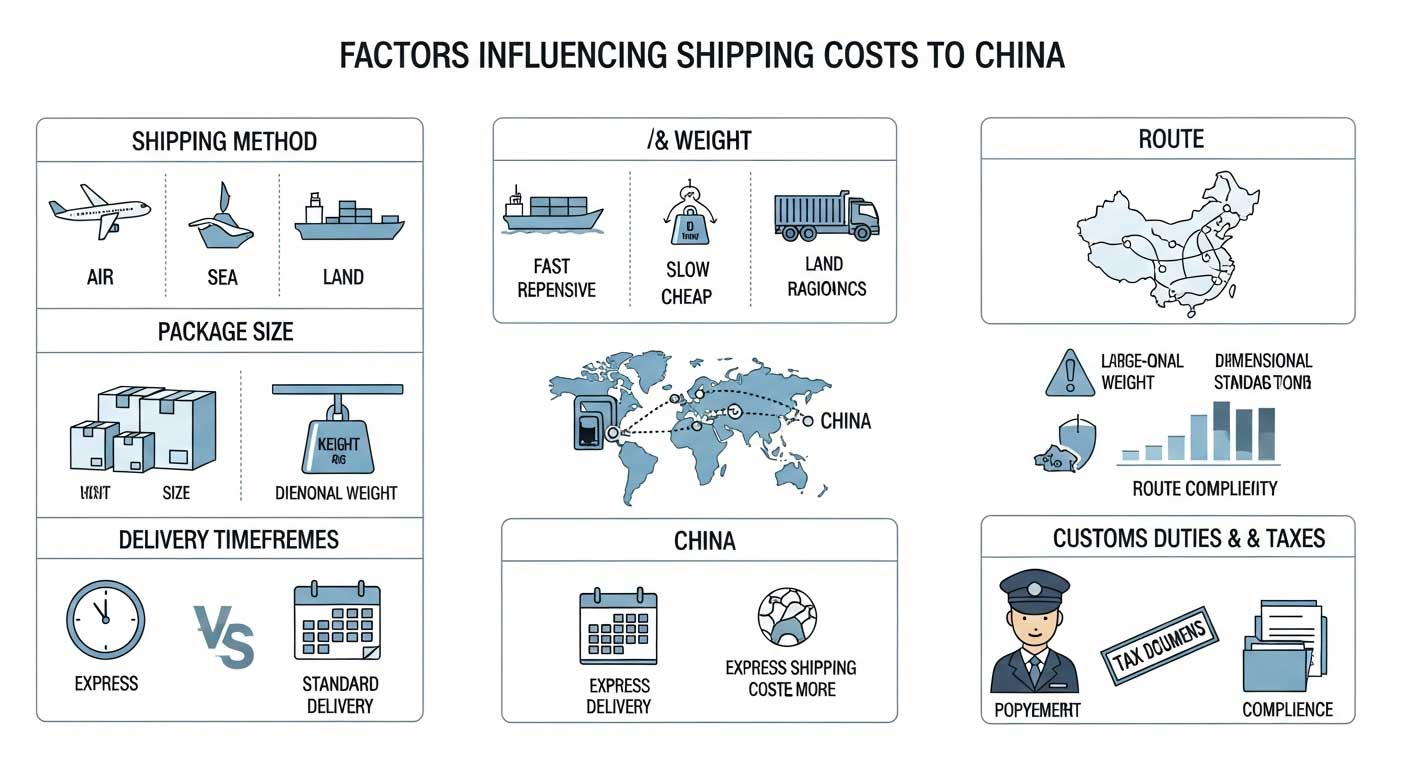
Factors Influencing Shipping Costs to China
Understanding the factors that influence shipping costs to China is crucial for businesses and importers to optimize logistics, reduce expenses, and ensure timely delivery. Multiple elements, from shipping method to customs duties, play a role in determining the final cost.
1. Shipping Method (Air, Sea, Land)
The mode of shipping directly impacts cost, speed, and reliability:
- Air freight is the fastest option but also the most expensive, making it ideal for urgent shipments or small packages.
- Sea freight is slower but cost-effective for large or heavy cargo, offering significant savings per kilogram.
- Land transport is suitable for regional shipments, balancing speed and affordability.
Choosing the right shipping method depends on your budget, cargo type, and delivery timeframe.
2. Package Size and Weight
Shipping costs are influenced by package dimensions and weight.
- Larger or heavier shipments require more space and fuel, increasing overall costs.
- Carriers often use dimensional weight pricing, which calculates cost based on both volume and actual weight.
- Optimizing packaging reduces wasted space and helps avoid extra charges for oversize or overweight shipments.
3. Shipping Distance and Route
The distance between origin and destination and the chosen route affect both cost and delivery time:
- Longer distances increase fuel consumption, labor, and transit fees.
- Complex routes that pass through multiple countries or regions may incur additional tariffs, tolls, and customs charges.
- Direct shipping routes are usually faster and more cost-effective.
4. Delivery Timeframes
The urgency of delivery also impacts shipping costs:
- Express or next-day shipping options are more expensive than standard methods.
- Planning shipments in advance allows importers to balance delivery speed with cost efficiency, selecting options that fit both budget and schedule.
5. Customs Duties and Taxes
Customs duties and import taxes are assessed by the destination country and vary based on:
- The type and value of goods
- The country of origin
- Local regulations and tariffs
Proper documentation and compliance help avoid delays, fines, or unexpected fees. Importers should always include customs duties in their total shipping budget to ensure accurate cost estimation.
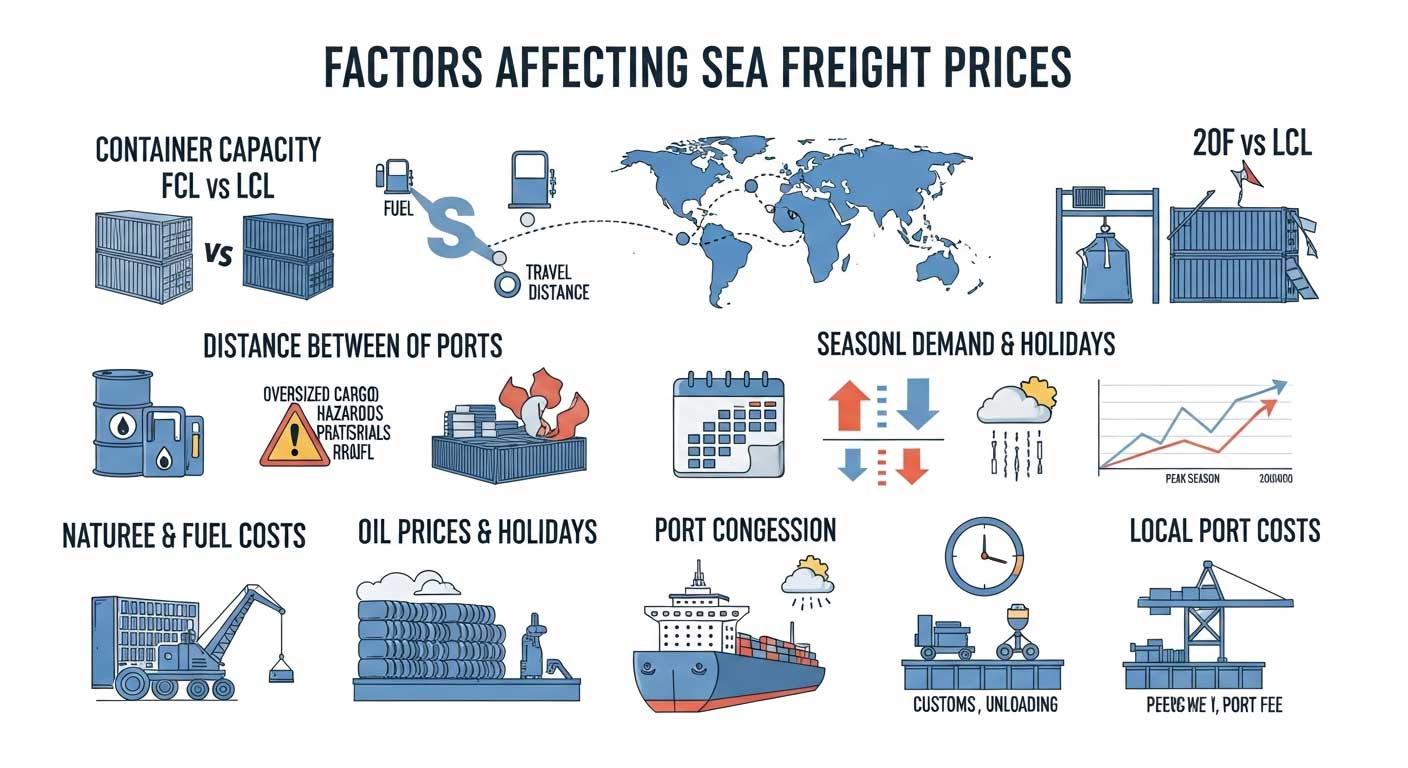
Shipping Methods and Their Costs
Choosing the right shipping method is essential for balancing speed, reliability, and cost. Each mode of transportation has its advantages and cost factors depending on cargo type, urgency, and destination.
1. Air Freight
Advantages:
- Fastest shipping option, ideal for urgent or time-sensitive shipments.
- Highly reliable with frequent flight schedules, reducing delivery time significantly.
Cost Factors:
- Air freight is generally more expensive due to high fuel costs, aircraft maintenance, and airport fees.
- Charges are calculated based on weight, volume, and distance.
2. Sea Freight
Advantages:
- Most cost-effective option for large volumes and heavy cargo.
- Suitable for non-urgent shipments with high capacity, ideal for bulk imports.
Cost Factors:
- Costs depend on fuel prices, port fees, and container types.
- Long transit times can affect overall logistics expenses.
- The choice between FCL (Full Container Load) and LCL (Less Container Load) also impacts pricing.
3. Express Couriers
Advantages:
- Fast, efficient, and ideal for small but urgent packages.
- Usually provides tracking and guaranteed delivery times, ensuring reliability.
Cost Factors:
- Premium services increase cost due to speed, handling, and added features.
- Prices are determined by weight, size, delivery speed, and service level.
4. Land Transport (For Neighboring Countries)
Advantages:
- Cost-effective for shipments to neighboring countries.
- Offers flexibility in routes and delivery schedules.
Cost Factors:
- Fuel, tolls, and border crossing fees are key contributors to cost.
- Additional expenses may include vehicle maintenance, driver wages, and insurance

How to Calculate Shipping Costs?
Estimating shipping costs accurately is essential for businesses and individuals to budget effectively and avoid unexpected expenses. Shipping costs depend on multiple factors, including package dimensions, weight, shipping method, distance, and additional fees. Here’s a step-by-step guide to calculate shipping costs:
1. Determine Package Details
Start by measuring your package accurately: length, width, height, and weight.
- Most shipping carriers calculate costs based on dimensional weight or actual weight, whichever is higher.
- Proper measurement ensures accurate pricing and avoids extra charges.
2. Choose the Shipping Method
Select the mode of transportation: air, sea, land, or express courier.
- Air freight is fast but more expensive.
- Sea freight is cost-effective for large or heavy shipments.
- Land transport works well for regional deliveries.
- Express couriers are ideal for small, urgent packages.
The chosen shipping method directly influences cost, speed, and reliability.
3. Calculate Distance and Route
Determine the distance between the origin and destination.
- Longer distances increase fuel, labor, and transit costs.
- Complex or indirect routes may add extra fees due to tariffs, tolls, or port charges.
4. Check Shipping Rates
Use carrier rate calculators or online tools to get the base shipping rate.
- Enter your package details and destination to estimate the cost.
- Compare rates from multiple carriers to find the most cost-effective option.
5. Include Additional Fees
Consider extra charges such as:
- Fuel surcharges, handling fees, and insurance
- Customs duties, taxes, and brokerage fees for international shipments
- The nature of your goods and destination country can affect these fees significantly.
6. Apply Discounts or Agreements
If you have a business account, bulk shipping agreement, or loyalty program, apply applicable discounts.
This can significantly reduce your overall shipping cost, especially for frequent shipments.
7. Calculate Total Shipping Cost
Add the base rate and additional fees, then subtract any discounts to get the total shipping cost.
- Ensure all possible charges are included to avoid unexpected expenses.
8. Review and Optimize
Compare the total cost across different carriers and shipping methods.
- Adjust your choices based on budget, delivery time, and reliability.
- Proper review ensures an optimized balance between cost-efficiency and service quality
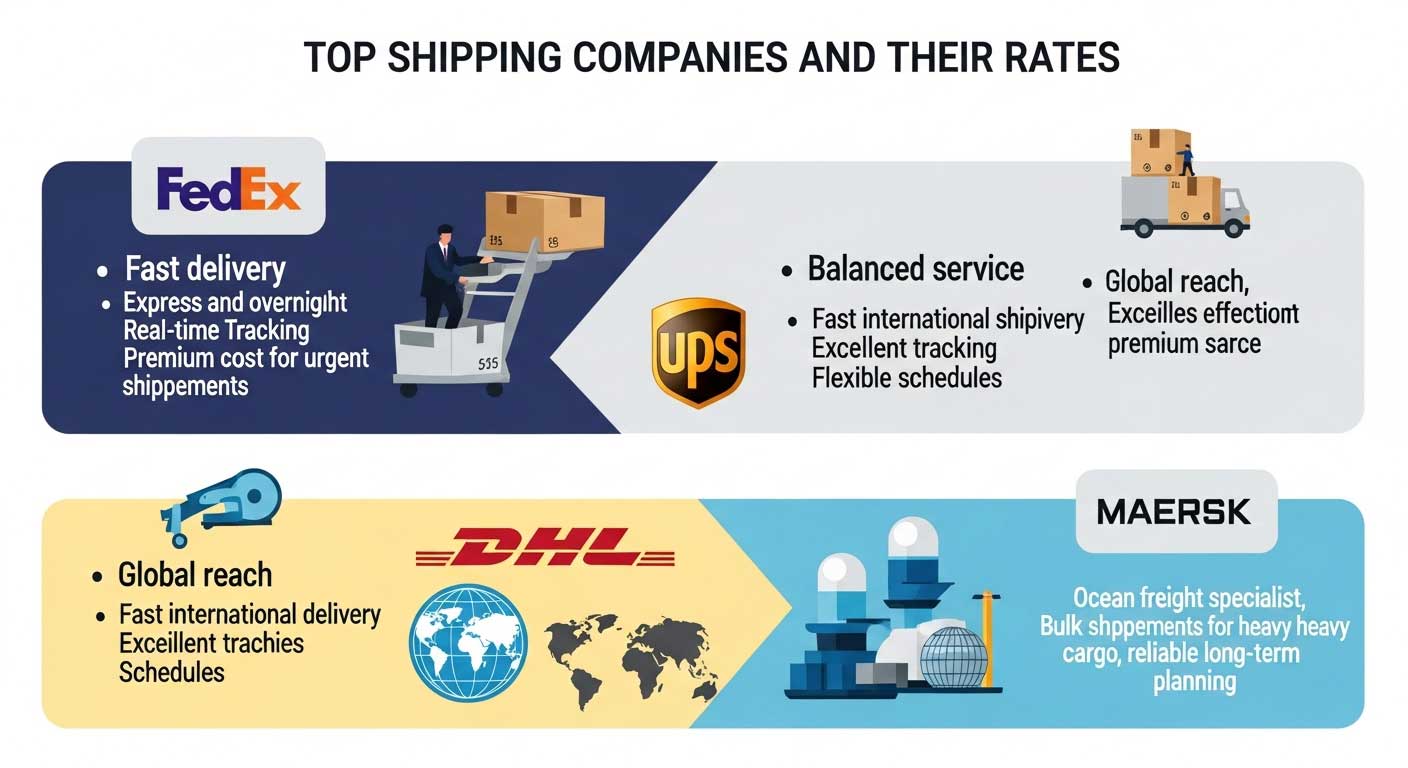
Shipping Companies and Their Rates: Choosing the Best Carrier for Your Shipments
When it comes to shipping goods domestically or internationally, selecting the right carrier can make all the difference. Each shipping company offers unique services, strengths, and pricing structures, so understanding them helps businesses and individuals optimize both cost and delivery reliability.
FedEx: Fast and Reliable for Urgent Shipments
FedEx is widely recognized for its speed and dependability, making it a go-to choice for urgent deliveries. Whether shipping by air or road, FedEx provides overnight and express options, along with advanced tracking systems that allow you to monitor your package in real-time. While their rates tend to be higher than slower shipping methods, the premium ensures that time-sensitive shipments arrive on schedule, making FedEx ideal for businesses that cannot afford delays.
UPS: Balanced Service with Global Reach
UPS combines logistical expertise and reliability with a wide range of shipping solutions. From UPS Ground and Air Services to UPS International, the company caters to both local and global shipments. UPS offers detailed tracking, bulk shipping options, and flexible delivery schedules, making it perfect for businesses looking for a balance between cost, reliability, and convenience.
DHL: The International Shipping Expert
For businesses that require global reach and fast delivery, DHL stands out as a top choice. Specializing in international shipping, DHL ensures speedy deliveries and excellent tracking capabilities. While express international shipments can be more expensive, DHL’s service guarantees timely delivery across continents, making it a reliable partner for companies expanding into global markets.
Maersk: The Leader in Ocean Freight
When it comes to bulk shipments and long-distance trade, Maersk is the industry leader in ocean freight. Ideal for transporting large volumes of goods, Maersk provides reliable shipping schedules and cost-effective solutions for businesses engaged in international trade. While ocean shipping takes longer than air freight, it remains the most economical choice for heavy or bulky cargo, especially for long-term logistics planning.
Comparison of Rates and Services
When selecting a shipping provider, it’s important to understand how rates, services, and delivery speed vary between carriers. Here’s a clear comparison of some of the top shipping companies:
FedEx and DHL: Fast but Premium
Both FedEx and DHL excel in international express shipping, offering fast, reliable delivery with advanced tracking. They are ideal for urgent shipments and small-to-medium packages that need to reach their destination quickly. However, the premium service comes at a higher cost, making them less suitable for large or low-priority shipments.
UPS: Balanced and Cost-Effective
UPS offers a strong combination of competitive pricing, reliability, and robust logistics support. Whether for domestic or international shipments, UPS provides flexible options, detailed tracking, and consistent service, making it a go-to choice for businesses that want a balance of cost-efficiency and dependable delivery.
Maersk: Economical for Bulk Sea Freight
For large shipments or bulk cargo, Maersk is the preferred choice. Specializing in ocean freight, Maersk provides cost-effective solutions for heavy consignments. While transit times are longer compared to air freight, the lower cost per unit makes Maersk ideal for businesses shipping large volumes internationally.
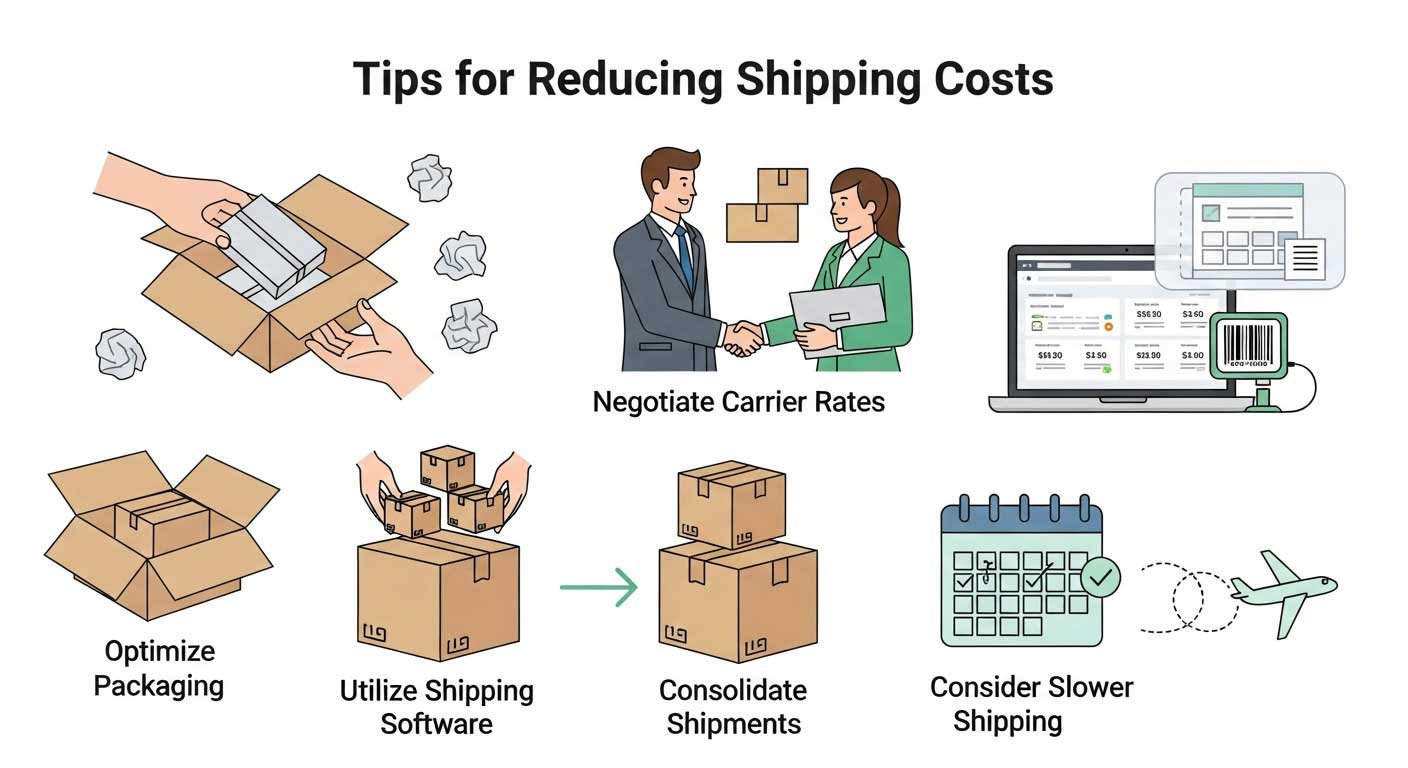
Tips for Reducing Shipping Costs
Reducing shipping costs is one of the biggest priorities for businesses that ship products regularly. With the right strategy—choosing the best shipping method, optimizing your packaging, and taking advantage of carrier programs—you can significantly cut your expenses without sacrificing delivery quality. Below are the most effective ways to lower your shipping costs.
1. Choose the Right Shipping Method
Picking the correct shipping method is the first and most important step. Each method has its own strengths depending on your shipment size, urgency, and destination:
- Air Freight: Fast and ideal for urgent or high-value shipments. However, it’s usually the most expensive option.
- Sea Freight: Best for large, heavy, or non-urgent cargo. Sea freight is the most cost-effective method for bulk shipments but comes with longer transit times.
- Land Transport: A great choice for regional deliveries or neighboring countries. It offers a good balance between price and delivery speed.
When choosing a method, always consider your budget, timeline, and cargo size to avoid unnecessary costs.
2. Optimize Package Size and Weight
Shipping carriers calculate prices based on both actual weight and dimensional weight. That means proper packaging is essential:
- Use the smallest possible box that safely fits the product.
- Choose lightweight but durable packing materials.
- Reduce empty space inside the package to avoid dimensional weight charges.
- Secure items properly to avoid damage and re-shipments, which increase costs.
Well-optimized packaging not only reduces shipping fees but also improves handling efficiency.
3. Use Consolidation Services
Consolidation (or freight consolidation) is one of the best methods for lowering international shipping costs:
- Multiple small shipments are combined into one bigger shipment.
- Costs are reduced because you share space with other shippers.
- Handling and customs clearance become simpler.
- Carriers can move cargo more efficiently, which may also shorten transit time.
Consolidation is especially useful for small and medium-sized businesses that ship regularly but don’t have full-container loads.
4. Take Advantage of Volume Discounts
Most carriers offer discounted rates for high-volume or frequent shipments:
- Negotiate better pricing based on your monthly or yearly shipping volume.
- Business accounts often unlock special rates, faster service, and priority support.
- If your volume is low, consider working with a third-party logistics provider (3PL) that already has bulk contracts with major carriers.
Using volume-based discounts is a simple way to reduce your per-shipment cost, especially for growing businesses.
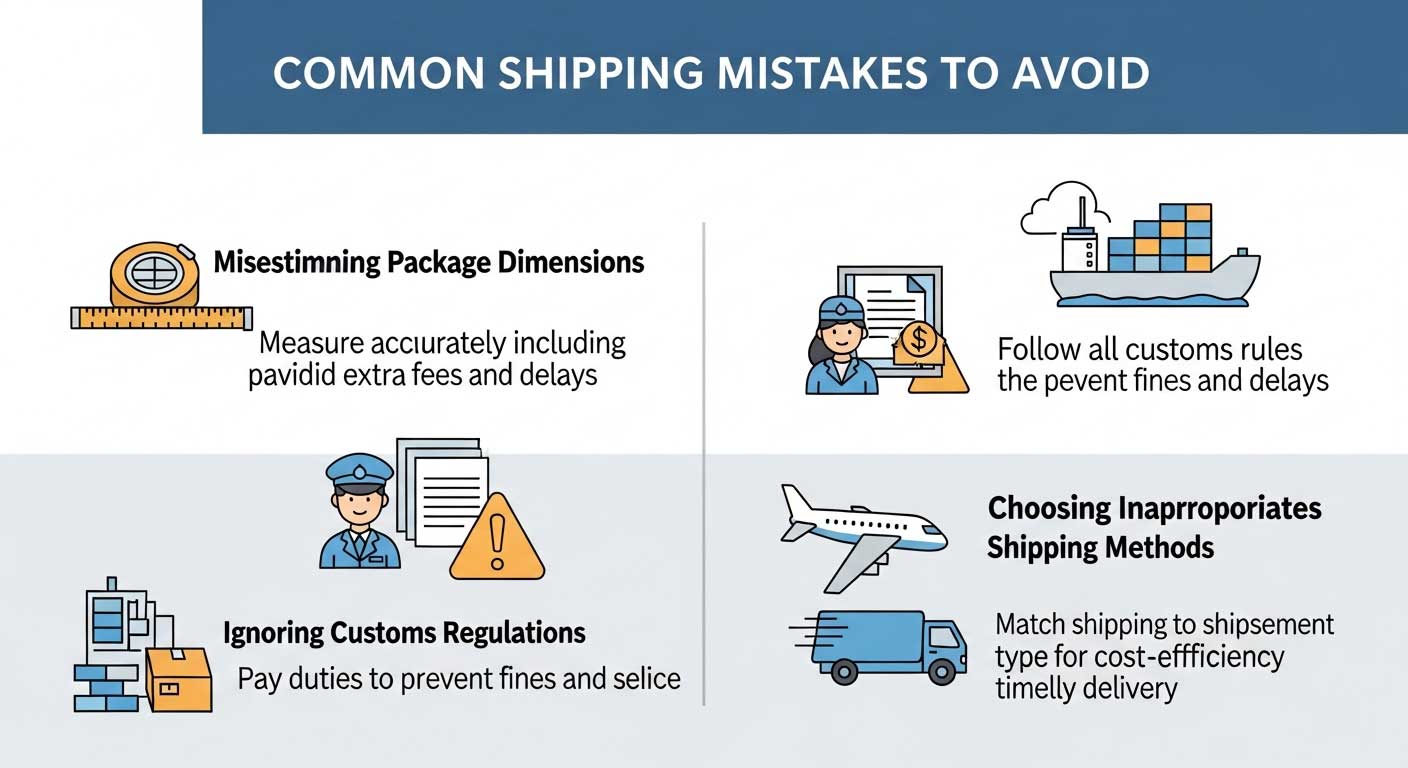
Common Mistakes to Avoid
Misestimating Package Dimensions:
Estimating the size of a package is important in trying to avoid unexpected charges. Misestimation may give way to higher shipping fees because of dimensional weight charges or may require expensive adjustments; always use exact measurements and include all packaging materials in your calculations. Always double-check your dimensions before you ship so that you are not paying any more than you should, or worse yet, causing delays due to wrong size information.
Ignoring Customs Regulations:
Ignorance of the regulations can lead to customs complications and may involve delays, fines, or seizure of merchandise. The rules on documentation, Forbidden items, and payment of duties are varying country by country. Ensure that you understand and observe all the customs requirements of both the country of origin and the country of destination. You will avoid complications and ensure that there are no problems at delivery if you correctly fill out the paperwork and pay whatever duties assessed. This also applies to the observance of all regulations dealing with import/export.
Choosing Inappropriate Shipping Methods:
The wrong shipping method will raise costs and/or delay delivery. For example, sending non-urgent items in bulk is prohibitively expensive by air freight, and using sea freight to send small urgent packages will not beat the deadline. Think through what you need: speed, cost, and size of shipment. Match the type of shipping method to your needs in terms of delivery.
Ocean Freight Rates Historical Charts for 2025
Will Freight Cost Increase in 2025?
Freight rates are always fluctuating due to the unstable shipping market. Currently, there is a significant drop in the shipping cost from China, making it an ideal time to import goods. Experts suggest that shipping to China costs could decrease further by 30% to 40%. However, these rates are likely to rise again during the peak shipping season from August to October 2025, or if there is a surge in demand for goods or container shortages.
Container Shipping Cost from China to the USA in 2025
Shipping from China to the US cost about varied in 2025. A 20-foot container price range usually ranges between $2,000 to $5,000 while it costs about $4,000 to $8,000 for a 40-foot container. FCL shipments are cost-effective if the volume of shipment is large. In this case, LCL is charged at approximately $300 to $500 per CBM.
In short, if you ask yourself a question: how much it costs to ship a container from China to the USA, here are some average prices that exist depending on a particular detail of shipping.
Shipping from China to the US can be route-based; hence, going through major ports like Shanghai to Los Angeles would cost less compared to the others. Apart from the above costs, the charges are port charges, customs duty, insurance, and inland transportation. Rates may fluctuate based on seasonal demand; for example, when summers and major holidays are near.
Air freight from China to the US is faster, but it is considerably more expensive than ocean freight. In order to get the best rates, quotes from various freight forwarders and shipping companies are recommended based on particular shipping needs.
Cost Of Shipping Container From CHINA to US
How Much Does It Cost To Bring a 40Foot Container From CHINA?
The table below shows the current shipping prices from China to the USA for a 40ft container.
| Origin (China) | Destination (USA) | Estimated Cost for 40ft Container (USD) |
|---|---|---|
| Shanghai | Los Angeles / Long Beach (West Coast) | $2,580 – $2,730 |
| China (General) | East Coast Ports (e.g., New York) | $3,600 – $4,500 |
| Shanghai / Ningbo | New York / Savannah | $4,500 – $5,500 |
| China | Houston | $4,500 – $7,000 |
Cheapest shipping to china from usa
Sea freight is usually the cheapest way to ship goods from the USA to China, especially if you have a large shipment, though this will take longer to arrive, usually 20-30 days. For small shipments, a consolidation service may be used, in which various shipments are combined into one to save money. Economy air freight provides a relatively faster alternative to sea freight and at more economical cost in comparison to express options. Pre-negotiated rates can be ensured by making use of a freight forwarder or shipping aggregator through the option comparison and negotiation of deals. Keep your eye on carrier promotions for the best rates.
Container Shipping Cost from China to Canada in 2025
Canada is one of the significant trade partners with China in various key imports such as electrical equipment, machinery, and apparel. Shipping options for importers include air freight, air express, and ocean freight. Shipping from China to Canada, especially ocean freight, gives reasonable rates for heavy goods but may entail up to 20-30 days for delivery. Shipping costs also depend on the type of service or size of a container. Follow our detailed article to know about the top 10 biggest ports in Canada in 2025, etc.
Factors affecting container shipping costs from China to Canada
When shipping containers from China to Canada, several factors influence the overall costs. Here’s a detailed look at these factors:
Service Type:
The prices vary based on whether it is a door-to-door or port-to-port service. Door-to-door services, which take care of the entire shipping for you, are more expensive and usually cost in the range of $2.25 to $2.6 per kilogram. On the other hand, port-to-port services may be cheaper but require more coordination on the importer’s part.
Container Size:
Size significantly affects the price of a container. In general, it is cheaper to send goods in a 20ft container than it is to use a 40ft, even though it can store more cargo. Due to volume, there isn’t linear scaling of a 40ft container in cost; therefore, for lighter shipments, the cost would be less expensive with a 20ft container.
Full Container Load (FCL) vs. Less than Container Load (LCL):
FCL cargo tends to be cheaper per cubic meter than LCL cargo because in an FCL shipment, the whole container is utilized by only one shipper. For example, the average LCL shipping from Shanghai has a cost of $679 per CBM while FCL has lower rates due to reduced handling and
Distance and Route:
The shipping rates also depend upon the distance between the port of loading in China and the destination port in Canada. Longer routes usually tend to be costlier due to increased fuel consumption and longer times of transit. These costs could be successfully minimized by efficient routing and selection of ports.
Cargo Type and Handling:
The shipping rates also depend upon the distance between the port of loading in China and the destination port in Canada. Longer routes usually tend to be costlier due to increased fuel consumption and longer times of transit. These costs could be successfully minimized by efficient routing and selection of ports.
Fuel Prices:
The shipping rate is directly linked with fuel price fluctuations. Higher fuel prices can increase the freight rate as a result of the carriers modifying their freight rates to battle with their fuel costs .
Seasonality and Demand:
Shipping costs are higher during peak seasons as demand for cargo space increases with bigger volumes. Shipping rates can, for example, be higher during holiday seasons.
Port Fees and Customs Duties:
The overall shipping cost includes the port charges and customs duties both in the ports of origin and destination. Such charges vary in different ports given that regulations may vary from one port to the other.
By understanding and considering the significant factors outlined above, the importers will be able to manage and, where possible, optimize their shipping cost from China to Canada.
40 Foot Container Shipping Cost From Chaina To Canada
The 40 feet container shipping cost from China to Canada starts at an estimated $4,000 to $8,000 for FCL price. Prices do fluctuate concerning the different particular ports involved in both China and Canada, among other aspects such as market demand or fuel prices. It ranges from $300 to $600 per cubic meter for LCL, depending on the volume shipped. It would be further encumbered with port charges, customs clearance charges, insurance charges, and inland transportation cost. The price may be better obtained by contacting the freight forwarder directly for current, correct, and accurate prices.
20 Foot Container Shipping Cost From Chaina To Canada
Speaking about transport from China into Canada, the shipping cost via FCL would fall in the range of $2,500 to $6,000. This, however, depends on the port of shipment and arrival, plus market conditions. In case the cargo volume is less than the container load or LCL, prices start at close to $300 to $600 per CBM. Furthermore, additional port charges, customs clearance, insurance, and inland transportation in Canada have to be considered. Freight rates change; thus, the best thing is to consult a freight forwarder for a more accurate quote valid upon inquiry.
Container Shipping Cost from China to Europe in 2025
Shipping from China to Europe has many variables that affect the cost of container shipping in the year 2025. It also depends on the size of the container where 20ft container shipping cost is cheaper compared to a 40ft container. Full container load shipment is usually cheaper for bigger volumes but less than a container load is more expensive where rates are quoted per cubic meter CBM.
Distance and the route chosen for shipping affect the cost directly; the longer the route and the more complicated, the more the cost is. Service type determines the price level too: door-to-door services are higher compared to port-to-port options due to the fact that they cover all logistics issues.
Weight, size, or special handling cargo characteristics might increase the cost, too. Fuel price fluctuations may affect the freight rates since high fuel prices would automatically mean higher costs of shipment.
The other factor affecting the costs is seasonal demand; peak seasons, like summer and big holidays, tend to increase costs. In addition, one can add port fees and customs duties at the ports of origin and destination.
It costs higher for Air Freight from China to Europe but the delivery time is faster. Generally, it ranges between $7,000 and $ 12,000 to ship a 40ft container from China to Europe. If it is an LCL shipment, it will cost somewhere in the range of $300 and $600 per CBM. Getting the quotes from different carriers can help in securing the best rates.
40 Foot Container Shipping Cost From Chaina To Europe
General prices of shipment for a 40-foot container from China to Europe start at $5,000 for FCL and can go up to $9,000, depending on the specific ports in China and Europe, market conditions, and fuel prices. For LCL shipments, this would go by the price range of $300 to $600 per CBM, depending on the volume of cargo that a shipper will send. Extra costs could include port charges, custom clearing, insurance, and inland transportation. It is best to contact a freight forwarder for more detailed information and the latest quotes.
20 Foot Container Shipping Cost From Chaina To Europe
From China to Europe, the shipment price of a 20 foot container ranges from $3,000 for FCL to $6,000. Prices depend on the cargo-handling ports, among other factors like market conditions and fuel prices. Prices for LCL range from $300 to $600 per CBM. Additional charges may include port fees, customs clearance, insurance, and inland transportation. The most accurate, current pricing will come from a direct inquiry to a freight forwarder.
Container Shipping Cost from China to Japan in 2025
Japan being the third largest economy in the world, keeps strong economic relations with China simply because of the reason for geographical proximity. shipping from China to Japan is efficient and quick; therefore, shipping of many kinds of goods is easily enabled.
The range of imports that Japan obtains from China includes electronics, machinery, apparel, plastics, furniture, optical devices, toys, vehicles, and chemicals. Ocean freight is generally used by the importers in Japan; it is cost-effective, though much slower than other modes, and heavy goods can be handled. Other options from China to Japan include air express and air freight, which involve faster transit times.
Ocean freight rates would depend on the distance to be covered, cargo dimension, container type, and the incoterms chosen, among other factors. Commonly used incoterms in shipments from China to Japan include: FOB, which means Free on Board, and CIF, an abbreviation for Cost, Insurance, and Freight.
Under FOB, the supplier is responsible only up to the loading of the goods in the transport. On the contrary, in the case of CIF terms, the supplier has to bear the cost and risk of delivering the goods up to the destination port.
40 Foot Container Shipping Cost From Chaina To Japan
On average, shipping by a 40-foot container from China to Japan costs for FCL, from $ 1,500 to $ 3,000. The actual price of shipping is decided by, but not limited to, the exact ports of both China and Japan being utilized, the market demand, and the fuel prices. For LCL, the costs can vary from $200 to $400 per CBM, given the volume shipped. These added costs could also involve port fees, customs clearances, insurance, and inland transportation. For a more precise and current quotation, please contact a freight forwarder directly.
20 Foot Container Shipping Cost From Chaina To Japan
The cost of shipping a 20 feet container from China to Japan is mostly in the range of $1,000 to $2,500 for FCL. This depends on which ports are used, the current market conditions, and fuel prices. In the case of LCL shipments, the costs usually come in the range of $200 to $400 per cubic meter (CBM). Other costs that may subsequently be charged include port charges, customs clearance charges, insurance, and inland transport arrangements. For the best and most current price, contact a freight forwarder directly.
How to get the best container shipping rates from China to Japan
To get the best rates when shipping goods from China to Japan:
Ensure you use good packaging materials that will not increase the volume of your goods
Consult various carriers before shipping
Get a reputable freight forwarder to work with you
Consider consolidating your goods
Container transit time from China to Japan usually ranges from 5 to 21 days. This is actually slow since Japan is close to China. The reason for this is that ships are generally slower, especially when they are carrying very heavy goods.
Final Takeaway
The key to effective shipping cost management and selection of an appropriate method requires consideration of a number of factors. Accurately estimating the dimensions of a package, understanding customs regulations and compliance with them, the selection of an appropriate method of shipment according to your needs-all this is crucially important. You can minimize errors and take advantage of consolidation services, optimize package size, volume discounts to make the process of shipment more cost-efficient and simple. Thoughtful planning and consideration of some of the choices involved will result in smoother, more economically viable shipping experiences and better logistics outcomes overall.
FAQ
What is the current sea freight cost from China?
The average sea freight cost for shipping goods from China to the USA ranges from $2 to $4 per kilogram. Shipping a 20ft container costs $277, while a 40ft container costs $377.
Why have shipping prices from China gone down in 2025?
Shipping prices have decreased due to lower demand and reduced sales of goods, primarily caused by ongoing lockdowns and closed companies. Additionally, high fuel prices and ample inventories have contributed to the decline in prices.
Will freight costs increase in 2025?
Freight rates are expected to continue dropping by 30% to 40%, but they may increase during the peak seasons of 2025, from August to October. Rates can also rise with increased demand or container shortages.
How much does it cost to ship containers from China to the USA?
The cost of shipping a 20ft container to the West Coast of the USA is around $8,500, while shipping to the East Coast is approximately $10,500. For a 40ft container, the cost is around $15,000 to the West Coast and $18,000 to the East Coast.
What are the container shipping costs from China to Canada in 2025?
Container shipping costs from China to Canada vary depending on factors such as service type (door-to-door or port-to-port) and shipment weight and volume. On average, shipping a 40ft container from Shanghai, Guangzhou, or Qingdao to Toronto costs around $6,900.
What are the container shipping costs from China to Europe in 2025?
Container shipping prices from China to Europe depend on factors like shipping mode (FCL or LCL), distance, weight, and cargo type. As an example, shipping from Shanghai to Southampton costs around $1,141.
How much does it cost to ship containers from China to Japan?
The cost of shipping a 20ft container from China to Japan using FOB incoterms is approximately $200. For LCL, the freight cost is around $60 per cubic meter (167 kg), while FCL rates are about $200 for a 20ft container and $300 for a 40ft container.
When will shipping prices go down?
Shipping prices are expected to stabilize around mid-2023. Factors such as increased container and vessel capacity, government actions, and reduced demand may contribute to subsequent price reductions, although fluctuations are still possible due to market volatility.
